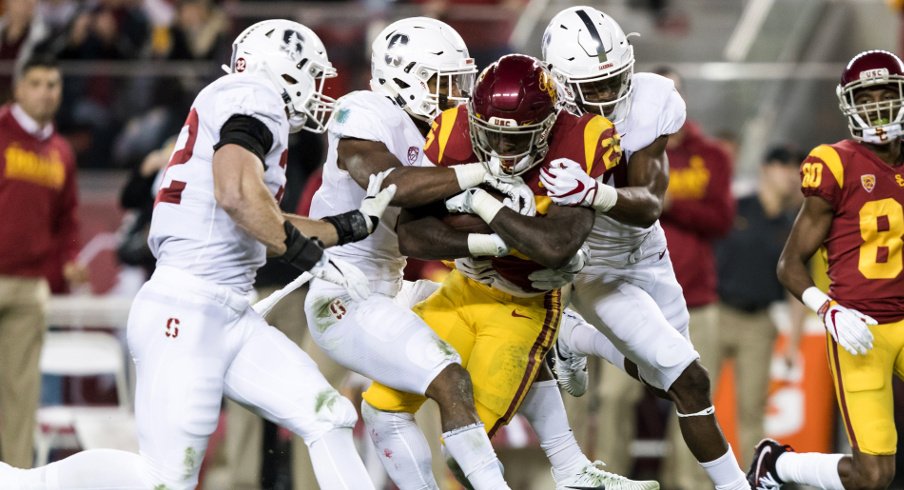Ohio State's path to beating USC may involve Ronald Jones II more than Sam Darnold.
Sam Darnold will be the focal point of strategic discussions about how the underdog Trojans compare with the Buckeyes. Darnold set a Rose Bowl record last year for total offense and led the Pac-12 in passing yards. He could be the No. 1 overall pick the 2018 NFL Draft if he 1) comes out early and 2) is okay playing in Cleveland. He will pose a special challenge to Ohio State's defense given how smart he is at identifying blitzes and beating them.
However, Ohio State's chances may hinge more on the favorable matchup against USC's rushing offense. Simply put, USC's rushing offense is mediocre at best and does not consistently surpass expectations against its opponents. Further, its disappearance in the middle of the season and overall meager showing against what are some dreadful rushing defenses in the Pac-12 should give some optimism to Ohio State fans in advance of the Cotton Bowl on the 29th.
Ronald Jones II effectively is USC's rushing offense. The junior tailback from Texas leads USC's rushing attack with 1,486 yards on the season. This is 58% of all USC's rushing yards in 2017. Further, he averages a respectable 6.14 yards per carry, 123 yards per game, and has 18 of USC's 28 rushing touchdowns. Nationally, he ranks No. 49, No. 9, and No. 5 in those respective categories.
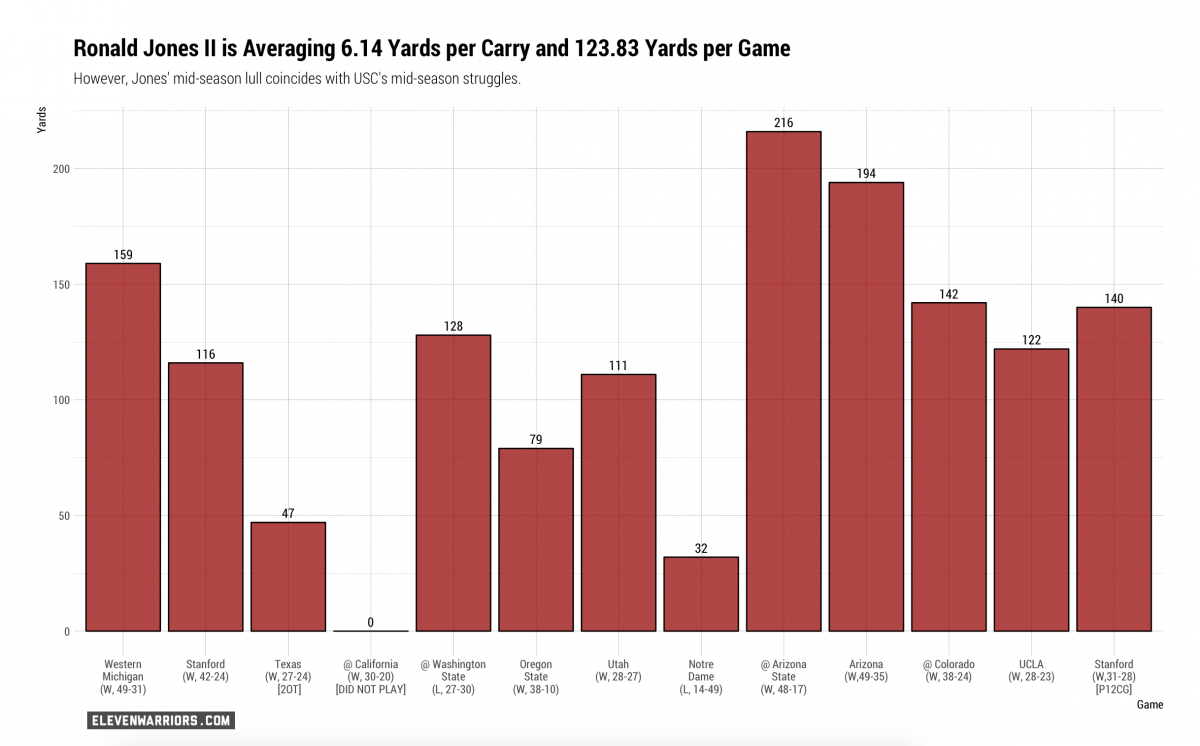
However, the overall statistics belie a pattern we also observe in USC's team overall this season. Jones started hot against Western Michigan but his production petered from there. The nadir was the Notre Dame loss in which the Irish routed the Trojans by 35 points and held Jones to a season-low 32 rushing yards (i.e. excluding the California game in which he did not play).
Thereafter, Jones caught fire against the two Arizona schools that were next on USC's schedule. However, his performance effectively regressed to the (overall good) mean in the remaining three games.
Jones' per-game rushing yardage is emblematic of USC's rushing offense through the course of the season. The Trojans started hot but disappeared in the middle of the season. This resulted in two losses to Washington State and Notre Dame that ultimately cost the Pac-12 champions a berth in the playoff.
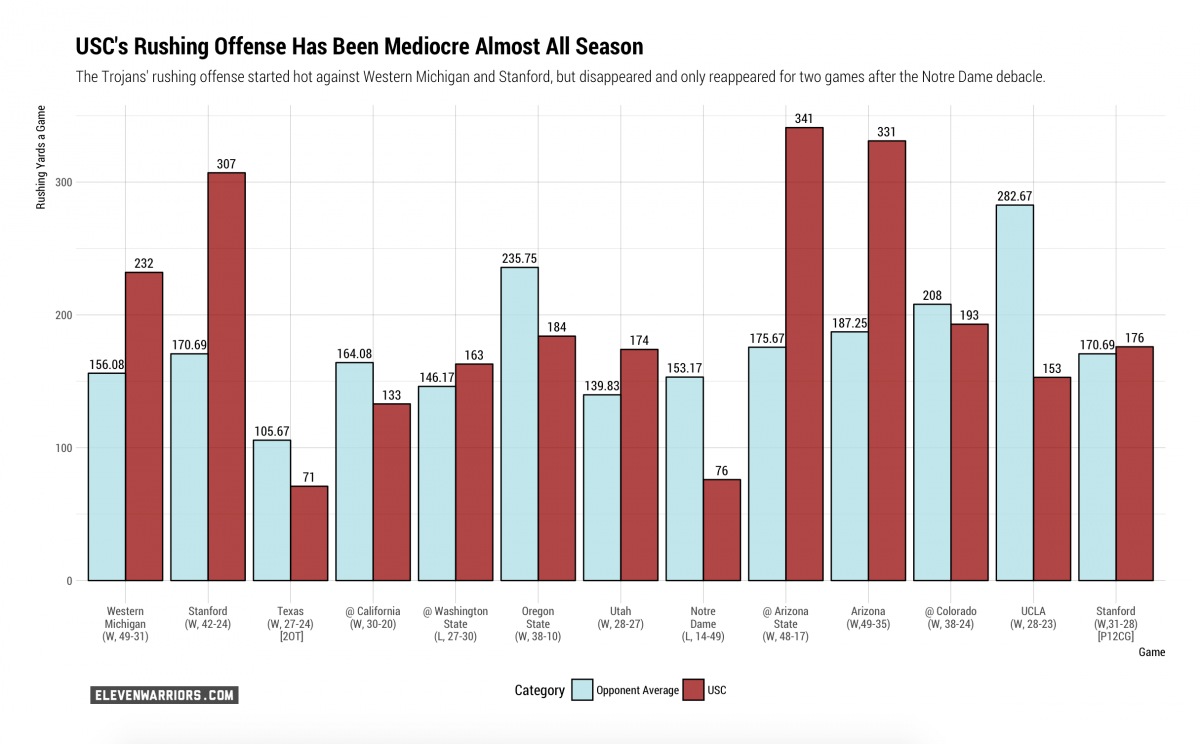
Notice how comfortably USC roasted the rushing defenses of its first two opponents. Western Michigan's rushing defense conceded an average of 156 rushing yards per game. USC hung 232 rushing yards on the season-opener, one of the key differences in a 49-31 win that was far closer than the final score suggests. Likewise, USC's rushing offense had a field day against the Cardinal the next week, posting 307 rushing yards on a defense that conceded an average of 170 rushing yards per game.
The Trojans subsequently hit a wall in the following games against Texas and California, narrowly eking out tough wins in those two games. Rushing wasn't necessarily the problem in the loss at Washington State but notice how meager the rushing offense was against an abjectly terrible Oregon State team.
Thereafter, it effectively hit rock-bottom in a blowout loss to Notre Dame. Texas' rushing defense performed better against the Trojans but USC's rushing output against the Irish relative to what the Irish typically allow was one of the biggest disparities this season for USC.
USC's rushing offense got its groove back in the next two games against Arizona State and Arizona, but this seemed like a temporary correction fueled by a collective anger from the Notre Dame loss. It regressed thereafter, including a curious showing against UCLA that should stand out more than it might. UCLA is the No. 129 rushing defense in the country and USC only mustered 54% of what UCLA typically allows in a game in that five-point home win.
The statistics for average yards per carry tell a similar story. Pay particular attention to how USC could not surpass the opponent's typical yard-per-carry statistic against Oregon State, Colorado, and UCLA. Those teams have the No. 121, No. 109, and No. 129 rushing defenses in the country.
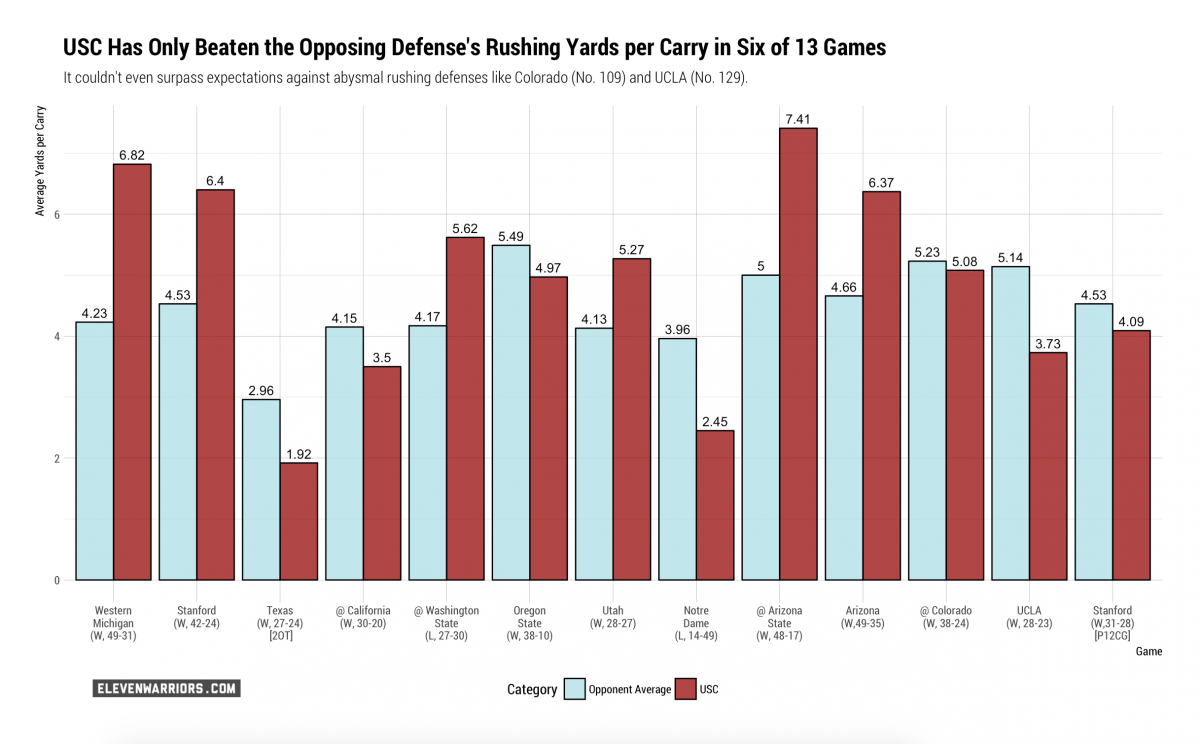
Ohio State fans should be excited about this matchup on paper for two reasons I'll illustrate with data. First, consider this graph we ran to break down the Ohio State win over Wisconsin.
Ohio State reliably holds all its opponents to well below their typical rushing output in a game. The only exception here is Iowa. We should note that game happened. It cannot unhappen. It's a non-trivial possibility it could recur in the Cotton Bowl. That said, that Iowa game was far from a typical showing for Ohio State's No. 8 rushing defense, which allows an average of 108 yards per contest.
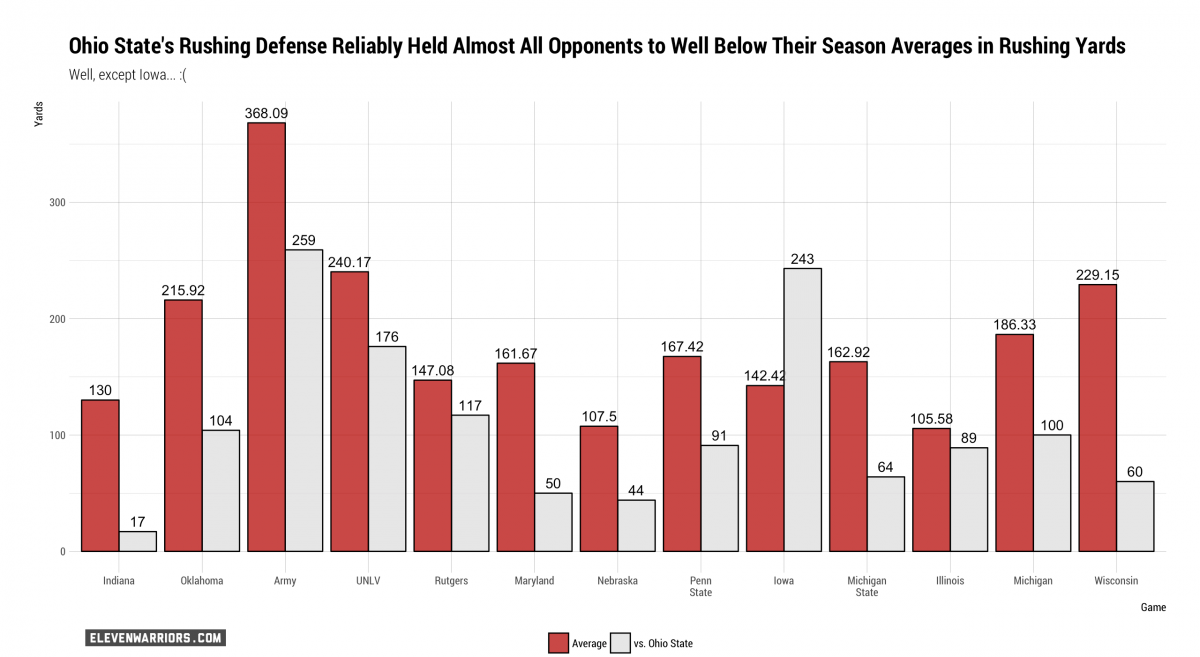
Second, compare the rushing offenses Ohio State played against the rushing defenses USC typically played. The typical rushing team Ohio State plays is the No. 66 rushing offense in the country (i.e. a team like Michigan State) that averages 180.92 rushing yards a game on 4.47 yards per carry. Its opponents to date include the No. 1 (Army), No. 18 (UNLV), No. 21 (Wisconsin), and No. 27 (Oklahoma) rushing teams in the country. And, with Iowa as the only (regrettably) clear outlier, Ohio State comfortably holds those rushing offenses to well below their typical output.
|
|
|
|||||||
|---|---|---|---|---|---|---|---|---|
| Game No. | Opponent | Rush Off. Rank | Yards | YPC | Opponent | Rush Def. Rank | Yards | YPC |
| 1 | Indiana | 106 | 130.08 | 3.48 | Western Michigan | 54 | 156.08 | 4.23 |
| 2 | Oklahoma | 27 | 215.92 | 5.6 | Stanford | 74 | 170.69 | 4.53 |
| 3 | Army | 1 | 355.83 | 6.12 | Texas | 7 | 105.67 | 2.96 |
| 4 | UNLV | 18 | 240.17 | 5.46 | California | 62 | 164.08 | 4.15 |
| 5 | Rutgers | 87 | 147.08 | 4.05 | Washington State | 43 | 146.17 | 4.17 |
| 6 | Maryland | 68 | 161.67 | 4.45 | Oregon State | 121 | 235.75 | 5.49 |
| 7 | Nebraska | 120 | 107.5 | 3.51 | Utah | 37 | 139.83 | 4.13 |
| 8 | Penn State | 61 | 167.42 | 4.86 | Notre Dame | 49 | 153.17 | 3.96 |
| 9 | Iowa | 93 | 142.42 | 3.87 | Arizona State | 80 | 175.67 | 5.00 |
| 10 | Michigan State | 66 | 162.92 | 3.92 | Arizona | 88 | 187.25 | 4.66 |
| 11 | Illinois | 122 | 105.58 | 3.28 | Colorado | 109 | 208.00 | 5.23 |
| 12 | Michigan | 43 | 186.33 | 4.51 | UCLA | 129 | 282.67 | 5.65 |
| 13 | Wisconsin | 21 | 229.15 | 5.09 | Stanford | 74 | 170.69 | 4.53 |
| AVG | 66 | 180.92 | 4.47 | 74 | 176.59 | 4.51 | ||
USC's rushing offense typically plays the No. 74 rushing defense (i.e. a team like Stanford, which USC played twice) that typically concedes 176 rushing yards a game and allows 4.51 yards per carry. Its opponents include the No. 109 (Colorado), No. 121 (Oregon State), and No. 129 (UCLA) rushing defenses in the country. Despite starting strong and taking out frustrations against the two Arizona schools, USC typically struggles to put up rushing yards against the bad rushing defenses it played.
It should also not be lost on anyone that USC's biggest offensive struggles in 2017 came against two of the best rushing defenses it saw on the schedule. The Trojans needed two overtimes to put away Texas (No. 7 rushing defense) and were routed in Notre Dame (No. 49 rushing defense).
Sam Darnold is going to occupy a lot of attention from Greg Schiano as the Buckeyes prepare for what will be the second-best passing offense it has seen all season. He should; he's probably the best pro prospect Ohio State has seen at any position all year.
However, Ohio State fans should be excited about the matchup with USC's rushing offense. USC's ground game, led by Ronald Jones II, seems like an an auxiliary part of the offense that puts more emphasis on Sam Darnold. However, USC's struggles in the ground game reliably coincide with USC's mid-season struggles notwithstanding the high-volume passing output from Sam Darnold. Cramping USC's ground game may be the difference in holding USC's overall offense in check.
Fans should be doubly excited in comparing Ohio State's defense to what USC has seen all season. As much as USC has the second-best passing offense Ohio State will have seen all season, the Trojans haven't quite seen a defense like Ohio State all year. It fared poorly against the closest comparisons (Texas, Washington State, Notre Dame).
